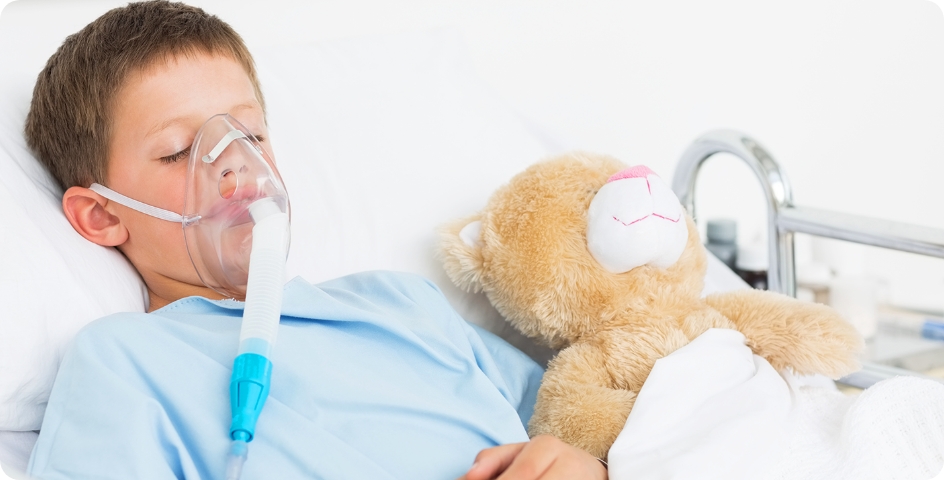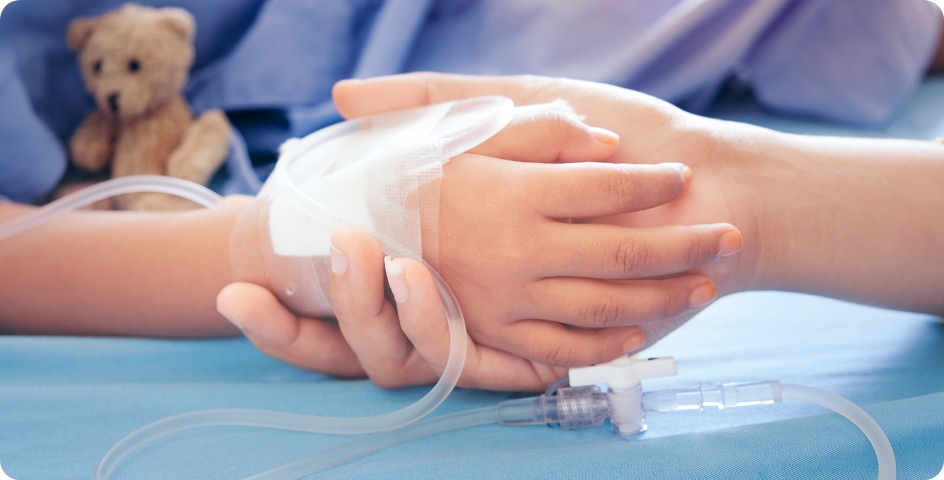Pediatric Oncology Treatment in Turkey
Healthy Türkiye helps you find the best pediatric oncology treatment in Turkey at affordable prices and adopts a 360-degree service approach in all areas of health through affiliated hospitals.
- Homepage
- Medical Treatment
- Pediatric Oncology Treatment in Turkey
- About Pediatric Oncology Treatment in Turkey
- Pediatric Oncology Treatment Procedure in Turkey
- Diseases Treated With Pediatric Oncology Treatment in Turkey
- Types of Pediatric Oncology Treatment in Turkey
- 2026 Cost of Pediatric Oncology Treatment in Turkey
- Why Choose Turkey for Pediatric Oncology Treatment?

About Pediatric Oncology Treatment in Turkey
Pediatric oncology treatment in Turkey stands out with its up-to-date technology and experienced surgeons. This situation makes Turkey very popular in the field of international health tourism. Pediatric oncology treatment researches and treats cancer in children. Childhood cancer is quite rare. About 1 in 500 children will be diagnosed with cancer by the age of 15, and most instances of cancer in children happen before the age of five. The chances of surviving cancer as a child are much higher than for adults, and more than 85% of children are completely cured.
If your child has cancer, they’ll be examined by a doctor who specializes in pediatric oncology treatment in turkey. This is the study and treatment of childhood cancer. Most cancers that are common in children are different from those seen in adults. Pediatric oncology treatments focus on cancers in infants, children, and teens. Specialists in pediatric oncology are specially trained to care for your child and keep them comfortable during their treatment.
A cancer diagnosis is upsetting at any age, but especially so when the patient is a child. It’s natural to have many questions, such as, who should treat my child, will my child get well, and what does all of this mean for our family? There are no answers to all your questions, but you can get detailed information that can reassure you by contacting our experts at Healthy Türkiye. We want you to know that we will always be with you.

Pediatric Oncology Treatment Procedure in Turkey
Pediatric oncology treatment focus on childhood cancer. One in 10,000 normal children have cancer during their childhood. The initial diagnosis might be frightening and stressful for the child and his/her parents. These emotions are not out of place. This case is rather understandable, but it is also compounded by a lack of information as well as some misconceptions. In most cases, there is no specific reason or cause for the child to have developed cancer as it is no one’s fault. Therefore, parents should not feel ashamed or guilty. The good news is that all childhood cancers can be treatable and most can be curable wit pediatric oncology treatment.
Cancer may affect any part of the body. The most commonly affected are blood, bones, and muscles. The familiar cancers include blood cancers (leukemia), cancers of the lymphatic system, (lymphomas), muscle and bone cancers (sarcomas), cancer of the brain and spinal cord, and other cancers seen in very young children (embryonal cancers). As of today, more than 83% of children with cancer are cured with pediatric oncology treatment, depending on the type of cancer they are suffering from.
Children are not adults; their requirements are different and they need to be treated by someone who is trained to look after them. Pediatric oncologists are responsible for treating all malignant cases among children, like leukemia, bone cancers, Wilms tumor, brain tumors, and spinal cord tumors, among several others. With timely, appropriate, and complete pediatric oncology treatment, the majority of children with cancer get cured and can lead peaceful lives.
What Does Paediatric Oncologist Do?
Pediatric oncologists, who are doctors specializing in the field of pediatric oncology, specialize in managing children who are suffering from cancer. There are a large number of doctors specializing in pediatric oncology in Turkey. Cancer might be in any location or system, including the blood (leukemia), brain, or body. They care for children and young patients and their families at all stages of treatment, from diagnosis to long-term follow-up or palliative care, and generally maintain support for many years.
Pediatric oncologists at pediatric oncology services work closely with hematologists, radiation oncologists, surgeons, pathologists, radiologists, endocrinologists, and other oncologists, nationally and internationally, to ensure therapies are appropriate and effective. They work locally with psychologists, social workers, and teachers to support patients and their families, ensuring that the burden of treatment is included and that the long-term effects of treatment are minimized.
Evidence-based medicine is at its core, and oncology is characterized by the expectation that patients will be treated according to clinical research whenever possible. As Healthy Türkiye, we are bringing you together with the best pediatric oncologists in Turkey.
What Does Pediatric Oncology Nurse Do?
Pediatric treatment for all types of cancer diagnoses in young patients in Turkey. Since each cancer has distinct symptoms and affects patient health differently, pediatric oncology nurses work with a wide range of medical cases and needs. Pediatric oncology nurses help patients prepare for and recover from surgical operations, conduct radiation and chemotherapy sessions, organize patients’ rehabilitation plans and monitor their vitals. They also update medical charts and inform physicians of any changes in patient’s conditions.
A major component of pediatric oncology nurses’ work is helping children and their families cope with cancer treatment procedures. Receiving a cancer diagnosis is a traumatic and upsetting event, but a pediatric oncology nurse’s presence might provide comfort in an otherwise stressful situation. Unlike older patients, children may be too young to understand what cancer is or what its implications may be. They also cannot make their own healthcare decisions, requiring additional coordination between specialists, nurses, patients, and families.
Causes of Childhood Cancer
The causes of most childhood cancers in pediatric oncology are not known. About 5 percent of all childhood cancer are caused by an inherited mutation. Most childhood cancer, like those in adults, is thought to develop as a result of mutations in genes that lead to uncontrolled cell growth and eventually cancer. In adults, these gene mutations reflect the cumulative effects of ageing and long-term exposure to cancer-causing substances.
However, identifying potential environmental factors of childhood cancer has been difficult, partly because cancer in children is rare and partly because it is difficult to determine what children may have been exposed to early in their development. For more information about the possible causes of cancer in children, you can contact our experts at Healthy Türkiye by calling us.

We Care About Your Health
Healthy Türkiye provides the best for your health and comfort. You will feel privileged with us.
7/24 Quality Personal Assistance Throughout Your Journey
Customizable for You All-Inclusive Packages
Get the Right Advice for your Health
Diseases Treated With Pediatric Oncology Treatment in Turkey
Childhood cancer is a general term in pediatric oncology treatments for a large group of diseases that can affect any part of the body. There are many types of childhood cancer and countless subtypes. Like adult cancer, childhood cancer types are disorders of the cells. Abnormal cells grow in an uncontrolled way, getting in the way of healthy, normal cells. These cells may metastasize and spread through the body. However, cancer in children requires its own type of treatment and cure. Understanding each type and subtype of childhood cancer can help researchers move closer to innovative specialized treatment.
Leukemia
Leukemia, a cancer of the bone marrow cells, is the of the most general types of childhood cancer in pediatric oncology. The bone marrow is the core or soft center of the long bones of the body where white blood cells, red blood cells, and platelets are created. White blood cells (called leukocytes) aid fight against infection. Red blood cells transport oxygen to the body. Platelets aid the body stop bleeding when it is injured.
In children with leukemia, the bone marrow creates a lot of abnormal, immature white cells that are unable to fight infection. Eventually, these leukemia cells crowd out healthy white blood cells, allowing viruses, bacteria, and other microorganisms to infect the body and make the person sick. Leukemia cells also crowd out the red blood cells and platelets, making it difficult for the body to get enough oxygen and stop bleeding after an injury. Types of leukemia involve:
You should have been obese for the last five years despite trying all non-invasive forms of losing weight and managing your obesity problems. This means you tried dietary plans, exercising, and weight loss medication. You will need to prove that you have tried these but without any success.
Acute myeloid leukemia (AML) – Abnormal growth of another type of white blood cell known as -myeloblasts and monoblasts.
Because leukemia cells abandon the bone marrow and enter the bloodstream, which goes everywhere in the body. Leukemia is a systemic disease. Leukemia can spread to blood vessels in the brain and spinal cord, the ovaries, the testicles, the kidneys, and other organs.
Lymphoma
Lymphoma is a cancer of the immune system that affects lymphoid tissues (lymph nodes and other glands in the body, such as the tonsils or thymus). Lymphoma cells are abnormal, immature white blood cells that can’t fight infection, crowding out the normal lymphoid tissue. This condition leaves the nodes or glands unable to defend the body against foreign invaders like viruses.
Lymphoma cells might also be found in the bone marrow and other organs of the body such as the liver or the spleen. Lymphoma can cause different signs, depending on where the cancer is. Types of lymphomas involve:
Hodgkin disease or Hodgkin lymphoma: Generally presents and progresses with gradual, persistent signs and symptoms such as fatigue, fever, and weight loss. The different subtypes of this lymphoma are treated in different ways and this disease is more common in adolescents.
Non-Hodgkin lymphoma: Signs and symptoms depend on the type of non-Hodgkin lymphoma, but generally appear and progress more rapidly than Hodgkin lymphoma. The three main types are called lymphoblastic lymphoma, mature B-cell lymphoma, and anaplastic large-cell lymphoma. The different subtypes are treated in different approaches.
Brain Cancers
There are various types of brain and spinal tumors, or cancers of the central nervous system, and the treatments are different. Brain and spine cancers occur from the abnormal growth of immature nerve or supportive cells in the brain or spine. These abnormal cells take up space in the brain or spinal cord. They might disrupt normal movement, sensation, thought, and/or behavior. There are four common types of childhood and adolescent brain cancers or tumors, depending on the types of cancer cells involved.
Astrocytomas: Occur from astrocytes or supportive tissue of the brain. They might be either low-grade which grows slowly and rarely spread to other parts of the brain, or high-grade which is more aggressive and can spread to other parts of the brain and the spinal cord.
Primitive neuroectodermal tumors: Occur from primitive nerve cells and are more known in children than in adolescents.
Brainstem gliomas: Occur in the bundle of nerve tissue at the base of the brain, where crucial functions such as heart rate, breathing, and swallowing are controlled.
Ependymomas: Generally occur in the lining of the brain’s ventricles, the four connected pockets within the brain. The ventricles create the cerebrospinal fluid that surrounds and cushions the brain and the spinal cord. If an ependymoma is present, the fluid generally sends the cancer cells around the brain and spine.
Neuroblastoma
Neuroblastoma is a cancer that begins with the abnormal growth of immature nerve cells, most frequently arising in the adrenal gland (an organ that makes hormones, located outside the kidneys). It can also occur in nerve tissue along the spine near the chest, neck, or abdomen. These abnormal cells can disrupt the normal function of the affected body sites and can spread to the skin, bones, bone marrow, lymph nodes, and liver.
Thyroid Cancer
Thyroid carcinoma, or thyroid cancer, is an abnormal growth of immature thyroid tissue that develops as a lump or lumps in the butterfly-shaped gland in the middle of the neck. This cancer breaks down the normal hormone production of the thyroid, which controls metabolism, heart rate, blood pressure, and body temperature. Thyroid cancer may spread into areas of the neck or to lymph nodes, bones, lungs, or sometimes the brain.
Bone Cancer
Primary bone cancers (cancers that start in the bones) occur frequently in older children and teens, but they might develop at any age. This cancer forms painful lumps on the bones, interfering with normal bone growth and stability. Primary bone cancers might spread to the lungs as well as to other bones and soft tissue. Primary bone cancer is different from metastatic bone cancer, which is an abnormal growth of immature cells from non-bone cells elsewhere in the body that then spreads to the bones. There are two basic types of primary bone cancers that occur in children:
Osteosarcoma: Generally arises during the growth spurt of puberty and about half of these bone cancers develop in the region of the knee.
Ewing sarcoma: This is a less common type of bone cancer that occurs most commonly in the pelvic (hip) bones, ribs, shoulder blades, upper legs, and arms.

Types of Pediatric Oncology Treatment in Turkey
After being diagnosed with cancer, the oncologists at Healthy Türkiye offer detailed counseling to parents about pediatric oncology treatment in Turkey. Treatments are available for all childhood cancers, and most children can be cured. The team should achieve that all children are comfortable and free of pain, as the treatment of childhood cancer is long and tough. The basic types of pediatric cancer treatment options available are:
Surgery for Pediatric Oncology Treatment in Turkey
The surgical operation might play a role in both cancer diagnosis and treatment, especially for solid tumors and lymphomas (lymph nodes that contain cancer). Surgeons specializing in pediatric oncology in Turkey might first take out a piece of the tumor, a procedure called a biopsy, so the tissue can be analyzed. This can define the exact type of cancer.
Surgeons might then extract as much of the cancer as possible before, during, or after other treatments are given that shrink the tumor for the best possible outcomes. Sometimes, surgery may damage the healthy tissue surrounding the tumor. A child might need supportive medication or care to help them heal from the surgery.
Radiation Therapy in Pediatric Oncology
Radiation therapy applies high-energy X-rays to destroy cancer cells. This procedure is performed by specialists in pediatric oncology services in Turkey. Radiation is produced by a machine called a linear accelerator, which sends high-energy X-rays directly into cancer. Radiation cannot be tasted, seen, or smelled, but the linear accelerator sometimes makes a clicking or humming noise during therapy. Each radiation therapy can last 10-30 minutes and might be given daily, for several days a week. The total treatment can last from 1 to 8 weeks, depending on the type of cancer.
Sometimes radiation might temporarily damage healthy tissue around the tumor being treated. Side effects, which generally depend on the type and location of cancer, might occur two- to three weeks after beginning treatment and last for several weeks. Supportive medicines are given to reduce various side effects.
Chemotherapy in Pediatric Oncology
Chemotherapy is the use of medications to help destroy cancer cells. Chemotherapy in pediatric oncology can be given in a number of different ways, by mouth, in the vein, into a muscle, into the spinal fluid, and under the skin. Generally, a combination of chemotherapy medicines is used together. The length of therapy depends on the type of cancer and how quickly the cancer responds. As with radiation, sometimes healthy cells in the body are affected too, but the damage is generally temporary. Each chemotherapy has unique side effects, but there are supportive medicines available to reduce them.
Hematopoietic Stem Cell & Bone Marrow Transplant in Pediatric Oncology Treatment
Stem cell transplants modify diseased or damaged bone marrow cells with healthy stem cells from bone marrow or umbilical cord blood that can make healthy new mature blood cells. There are two basic types of bone marrow transplants used to treat childhood cancers:
Autologous transplant: This type of transplant harvests the child’s own stem cells and freezes them for later application. It begins with very high doses of chemotherapy to kill cancer cells. After chemotherapy, a stimulant protein is given daily to force stem cells out of the bone marrow. The cells are then collected using a special device in a process called apheresis, which separates the blood into its different parts. The frozen stem cells are then thawed and put back into the patient’s bloodstream. These healthy stem cells go to the healthy marrow to grow healthy blood cells.
Allogeneic transplant: This type of transplant collects stem cells from another person, generally a brother or sister. Before donated stem cells are transplanted, chemotherapy with or without radiation is applied to destroy the patient’s bone marrow. The new donated stem cells are infused into the bloodstream to create new blood cells. Since patients are vulnerable to infection and various other side effects during stem cell transplants, they generally need to stay in the hospital for a while. A hospital stay also helps specialists watch closely for any complications, such as the body rejecting the transplanted cells.
Targeted Therapy in Pediatric Oncology
Targeted therapy, sometimes called molecular therapy or precision medicine, works by targeting and destroying cancer’s specific mutated genes, proteins, or surrounding tissue. Targeted therapy might be applied in combination with other treatments, such as chemotherapy.
There are different types of targeted cancer therapies in pediatric oncology. The two main types involve small molecule drugs that work inside cancer cells, and monoclonal antibodies that attach to the outside of cancer cells. Some mark cancer cells so that they are better seen and destroyed by the immune system. Others destroy or stop cancer cells from growing. Still, others transport toxins to cancer cells or target a specific genetic defect in the tumor.
Although the hope of targeted therapy is to reduce any side effects on healthy tissue, even targeted therapy has side effects that are manageable with supportive drugs and care from the pediatric oncologist.
After Pediatric Oncology Treatment in Turkey
During pediatric oncology treatment, most families are mainly concerned about the daily aspects of getting through treatment and beating cancer. After pediatric oncology treatment, the concerns tend to shift toward the long-term effects of cancer and its treatment, and concerns about cancer return. It is definitely normal for families to want to put cancer and its treatment behind them and get back to a life that doesn’t revolve around cancer. But it’s important to realize that close follow-up care is a central part of this process that provides children with the best chance for recovery and long-term survival.
Once treatment is finished, the expert healthcare team at Healthy Türkiye will set up a follow-up schedule. For many years after pediatric oncology treatment, it is very important that children have regular follow-up exams with the cancer care team. As time goes by, the risk of cancer coming back goes down.
Specialist visits may be needed less frequently, but they are still important because some side effects of treatment may not show up until years later. Because of big advances in pediatric oncology treatment, more children treated for cancer now survive into adulthood. But treatments may affect children’s health later in life, so watching for health effects as they get older has become more of a concern in recent years. The earlier any issues are recognized, the more likely it is that they can be treated effectively.
Getting Support for Pediatric Oncology Treatment in Turkey
Learning that your child has cancer affects every part of your family’s life. To help your family understand and adjust, most specialists will suggest services to support your child. Your specialist at Healthy Türkiye might ask that you and your child speak with a psychologist or counselor to help your family understand your child’s cancer.
Many of the childhood cancer centers at Healthy Türkiye provide a friendly atmosphere to help your child feel safe during their treatment. Social workers are generally available to help your child adjust their school and social schedules around their treatment. Your specialists are taught to speak to your family and child about their cancer treatment in an easy-to-understand and comforting way.

2026 Cost of Pediatric Oncology Treatment in Turkey
All types of medical attention, like pediatric oncology treatment, are very affordable in Turkey. Many factors are also included in determining the cost of pediatric oncology treatment in Turkey. Your process with Healthy Türkiye will last from the time you decide to have a pediatric oncology treatment in Turkey until the time you are fully recovered, even if you are back home. The exact pediatric oncology treatment procedure cost in Turkey depends on the type of operation involved.
The cost of pediatric oncology treatment in Turkey does not demonstrate many variations in 2026. Compared to costs in developed countries like the United States or the UK, pediatric oncology treatment costs in Turkey are relatively low. So, it’s no wonder patients from across the world visit Turkey for pediatric oncology treatment procedures. However, price is not the only factor affecting choices. We suggest looking for hospitals that are safe and have pediatric oncology treatment reviews on Google. When people decide to seek medical help for pediatric oncology treatment, they will not only have had low-cost procedures in Turkey, but also the safest and best treatment.
At clinics or hospitals contracted with Healthy Türkiye, patients will receive the best pediatric oncology treatment from specialist doctors in Turkey at affordable rates. Healthy Türkiye teams provide medical attention, pediatric oncology treatment procedures, and high-quality treatment to patients at a minimum cost. When you contact Healthy Türkiye assistants, you can get free information about the cost of pediatric oncology treatment in Turkey and what this cost covers.
The price of pediatric oncology treatments in the UK is in the range of £45.000-£70.000.
The price of pediatric oncology treatments in the USA is in the range of $130.000-$205.000.
The price of pediatric oncology treatments in Türkiye is in the range of $15.000-$25.000.
Price of Pediatric Oncology Treatment in the UK
Price of Pediatric Oncology Treatment in the USA
Price of Pediatric Oncology Treatment in Türkiye
Why Is Pediatric Oncology Treatment Cheaper in Turkey?
One of the main considerations before traveling abroad for pediatric oncology treatment is the cost-effectiveness of the whole process. Many patients think that when they add flight tickets and hotel expenses to their pediatric oncology treatment costs, it will become very expensive to travel, which is not true. Contrary to popular belief, round-trip flight tickets to Turkey for pediatric oncology treatment can be booked very affordably.
In this case, assuming you are staying in Turkey for your pediatric oncology treatment, your total travel expense of flight tickets and accommodation will only cost less than any other developed country, which is nothing compared to the amount that you are saving. The question “Why is pediatric oncology treatment cheaper in Turkey?” is so common among patients or people simply curious about getting their medical treatment in Turkey. When it comes to pediatric oncology treatment prices in Turkey, there are 3 factors allowing for cheaper prices:
The currency exchange is favorable for whoever looking for pediatric oncology treatment has a euro, dollar, or pound;
The lower cost of living and cheaper overall medical expenses such as pediatric oncology treatment;
For pediatric oncology treatment, incentives are given by the Turkish Government to medical clinics working with international clients;
All these factors allow for cheaper pediatric oncology treatment prices, but let’s be clear, these prices are cheaper for people with strong currencies (as we said, euro, dollar, Canadian dollar, pound, etc).
Every year, thousands of patients from all over the world come to Turkey to get pediatric oncology treatment. The success of the healthcare system has increased in recent years, especially for pediatric oncology treatment. It’s easy to find well-educated and English-speaking medical professionals in Turkey for all kinds of medical treatment, such as pediatric oncology treatment.

Why Choose Turkey for Pediatric Oncology Treatment?
Turkey is a common choice among international patients seeking advanced pediatric oncology treatment. Turkey’s health procedures are safe and effective, with a high success rate, like pediatric oncology treatment. The increasing demand for high-quality pediatric oncology treatment at affordable prices has made Turkey a popular medical travel destination. In Turkey, pediatric oncology treatment is performed by highly experienced and trained doctors with the most advanced technology in the world. Pediatric oncology treatment is done in Istanbul, Ankara, Antalya, and other major cities. The reasons for choosing pediatric oncology treatment in Turkey are as follows:
High-quality hospitals: Joint Commission International (JCI) accredited hospitals have dedicated pediatric oncology treatment units that are specially designed for patients. International and national strict protocols provide effective and successful pediatric oncology treatment for patients in Turkey.
Qualified experts: The expert teams include nurses and specialist doctors, together to carry out pediatric oncology treatment according to the patient’s needs. All the included doctors are highly experienced in performing pediatric oncology treatment.
Affordable price: The cost of pediatric oncology treatment in Turkey is affordable compared to Europe, the USA, the UK, Singapore, Australia, etc.
The high success rate: Highly experienced specialists, the best available technology, and stringently followed safety guidelines for post-operative care of the patient, resulting in a high success rate for pediatric oncology treatment in Turkey.
Is Pediatric Oncology Treatment Safe in Turkey?
Did you know Turkey is one of the most visited destinations for pediatric oncology treatment in the world? It is ranked as one of the most popular tourist destinations for pediatric oncology treatment. Over the years, it has also come to be a very popular medical tourism destination, with many tourists coming in for pediatric oncology treatment. There are so many reasons why Turkey stands out as a leading destination for pediatric oncology treatment. Because Turkey is both safe and easy to travel to, with a regional airport hub and flight connections to pretty much everywhere, it is preferred for pediatric oncology treatment.
The best hospitals in Turkey have experienced medical staff and specialists who have performed thousands of medical services, such as pediatric oncology treatment. All procedures and coordination related to pediatric oncology treatment are controlled by the Ministry of Health in accordance with the law. Over many years, the greatest progress in medicine has been observed in the field of pediatric oncology treatment. Turkey is known among foreign patients for its great opportunities in the area of pediatric oncology treatment.
To emphasize, besides the price itself, the key factor in selecting a destination for pediatric oncology treatment is certainly the standard of medical services, the hospital staff’s high level of expertise, hospitality, and the safety of the country.
All-Inclusive Packages for Pediatric Oncology Treatment in Turkey
Healthy Türkiye offers all-inclusive packages for pediatric oncology treatment in Turkey at much lower prices. Extremely professional and experienced doctors and technicians carry out the high quality pediatric oncology treatment. The cost of pediatric oncology treatment in European countries can be quite expensive, especially in the UK. Healthy Türkiye provides cheap all-inclusive packages for a long and short stay of pediatric oncology treatment in Turkey. Because of many factors, we can provide you with many opportunities for your pediatric oncology treatment in Turkey.
The price of pediatric oncology treatment differs from other countries due to medical fees, staff labor prices, exchange rates, and market competition. You can save much more in pediatric oncology treatment compared to other countries in Turkey. When you purchase a pediatric oncology treatment all-inclusive package with Healthy Türkiye, our healthcare team will present a list of hotels for you to choose from. In pediatric oncology treatment travel, the price of your stay will be included in the all-inclusive package cost.
In Turkey, when you purchase pediatric oncology treatment all-inclusive packages through Healthy Türkiye, you will always receive VIP transfers. These are provided by Healthy Türkiye, which has contracted with highly qualified hospitals for pediatric oncology treatment in Turkey. Healthy Türkiye teams will organize everything about pediatric oncology treatment for you and have you picked up from the airport and safely brought to your accommodation.
Once settled in the hotel, you will be transferred to and from the clinic or hospital for pediatric oncology treatment. After your pediatric oncology treatment has been successfully completed, the transfer team will return you to the airport in time for your flight home. In Turkey, all packages of pediatric oncology treatment can be arranged upon request, which relaxes the minds of our patients. You can reach out to Healthy Türkiye for everything you need to know about pediatric oncology treatment in Turkey.
The Best Hospitals in Turkey for Pediatric Oncology Treatment
The best hospitals in Turkey for pediatric oncology treatment are Healthy Türkiye, Memorial Hospital, Acıbadem International Hospital, and Medicalpark Hospital. These hospitals attract patients from all over the world seeking pediatric oncology treatment due to their affordable prices and high success rates.
Best Doctors and Surgeons in Turkey for Pediatric Oncology Treatment
The best doctors and surgeons in Turkey for pediatric oncology treatment are highly skilled professionals who offer specialized care and advanced procedures. With their expertise and state-of-the-art techniques, these specialists ensure that patients receive high-quality pediatric oncology treatment and achieve optimal health results.

Frequently Asked Questions
Among children (ages 0 – 14 years), the most common types of cancer are leukemia, followed by brain tumors, lymphomas, neuroblastoma, kidney tumors, and malignant bone tumors.
For most types of cancer, a biopsy is the only sure way for the specialist to know if a site of the body has cancer. In a biopsy, the specialist takes a small sample of tumor tissue for testing in a laboratory. If a biopsy is not possible, the specialist might suggest other tests that will help make a diagnosis.
Rare tumors that only occur in children involve pancreatoblastoma, malignant rhabdoid tumors, and melanotic neuroectodermal tumors of infancy.
A few environmental factors, such as radiation exposure, have been connected with some types of childhood cancers. Some studies have also suggested that some parental exposures may increase a child’s risk of certain cancers, but more studies are needed to explore these possible links.
Access to effective diagnosis, essential drugs, pathology, blood products, radiation therapy, technology, and psychosocial and supportive care is variable and inequitable around the world. However, a cure is possible for more than 80% of children with cancer when childhood cancer services are accessible.
Unlike various cancers in adults, childhood cancers are not strongly linked to lifestyle or environmental risk factors. And only a small number of childhood cancers are caused by DNA changes that are passed from parents to their children.
